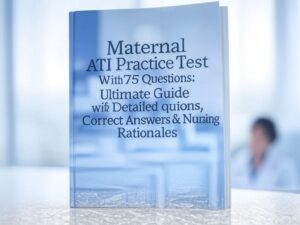Elevate your preparation for the Maternal ATI Exam 2025 with this all-inclusive practice test, featuring 75 meticulously curated questions, correct answers, and in-depth nursing rationales to ensure a thorough understanding of maternal and newborn care. This ultimate guide is designed specifically for nursing students and professionals aiming to excel in their ATI exams, NCLEX preparation, or maternal nursing certification. Each question is aligned with the 2025 ATI exam blueprint, covering high-yield topics such as prenatal care, labor and delivery, postpartum care, and neonatal nursing. The detailed answers and nursing rationales provide clarity on complex concepts, helping you build critical thinking skills essential for real-world clinical practice. Whether you’re looking to reinforce your knowledge, identify weak areas, or gain confidence for the exam, this practice test offers a robust framework for success. Study efficiently, master maternal health principles, and achieve your nursing goals with this indispensable Maternal ATI Practice Test 2025 resource.
Preview
1. A nurse is planning care for a client with a prescription for oxytocin. Which of the
following is a contraindication to the use of this medication?
A. Prolonged rupture of membranes at 38 weeks gestation
B. Intrauterine growth restriction
C. Post-term pregnancy
D. Active genital herpes ✅
Rationale: Oxytocin is contraindicated for clients with active genital herpes because the
virus can be transmitted to the newborn during vaginal delivery. A cesarean birth is
recommended in this case.
2. A nurse cares for a client with a soft uterus and increased lochial flow. Which
medication should the nurse plan to administer to promote uterine contractions?
A. Terbutaline
B. Nifedipine
C. Magnesium sulfate
D. Methylergonovine ✅
Rationale: Methylergonovine is an ergot alkaloid that promotes uterine contractions and is
used to manage postpartum hemorrhage due to uterine atony.
3. A nurse is discussing risk factors for necrotizing enterocolitis (NEC) in newborns
with a newly licensed nurse. Which of the following risk factors should the nurse
include?
A. Post-term birth
B. Macrosomia
C. Respiratory distress syndrome ✅
D. Maternal gestational diabetes
Rationale: Respiratory distress syndrome (RDS) can lead to intestinal ischemia due to
hypoxia, increasing the risk for NEC in preterm infants.
4. A nurse is performing an initial physical assessment of a newborn following a
vaginal birth. Which of the following findings should the nurse report to the provider?
A. Small, pinpoint, reddish-purple spots on the chest ✅
B. Bluish coloring of the feet
C. Overlapping suture lines
D. White, cheese-like substance covering the skin
Rationale: Petechiae (tiny red or purple spots) on the chest may indicate infection or
thrombocytopenia and should be reported to the provider.
following is a contraindication to the use of this medication?
A. Prolonged rupture of membranes at 38 weeks gestation
B. Intrauterine growth restriction
C. Post-term pregnancy
D. Active genital herpes ✅
Rationale: Oxytocin is contraindicated for clients with active genital herpes because the
virus can be transmitted to the newborn during vaginal delivery. A cesarean birth is
recommended in this case.
2. A nurse cares for a client with a soft uterus and increased lochial flow. Which
medication should the nurse plan to administer to promote uterine contractions?
A. Terbutaline
B. Nifedipine
C. Magnesium sulfate
D. Methylergonovine ✅
Rationale: Methylergonovine is an ergot alkaloid that promotes uterine contractions and is
used to manage postpartum hemorrhage due to uterine atony.
3. A nurse is discussing risk factors for necrotizing enterocolitis (NEC) in newborns
with a newly licensed nurse. Which of the following risk factors should the nurse
include?
A. Post-term birth
B. Macrosomia
C. Respiratory distress syndrome ✅
D. Maternal gestational diabetes
Rationale: Respiratory distress syndrome (RDS) can lead to intestinal ischemia due to
hypoxia, increasing the risk for NEC in preterm infants.
4. A nurse is performing an initial physical assessment of a newborn following a
vaginal birth. Which of the following findings should the nurse report to the provider?
A. Small, pinpoint, reddish-purple spots on the chest ✅
B. Bluish coloring of the feet
C. Overlapping suture lines
D. White, cheese-like substance covering the skin
Rationale: Petechiae (tiny red or purple spots) on the chest may indicate infection or
thrombocytopenia and should be reported to the provider.












Reviews
There are no reviews yet.